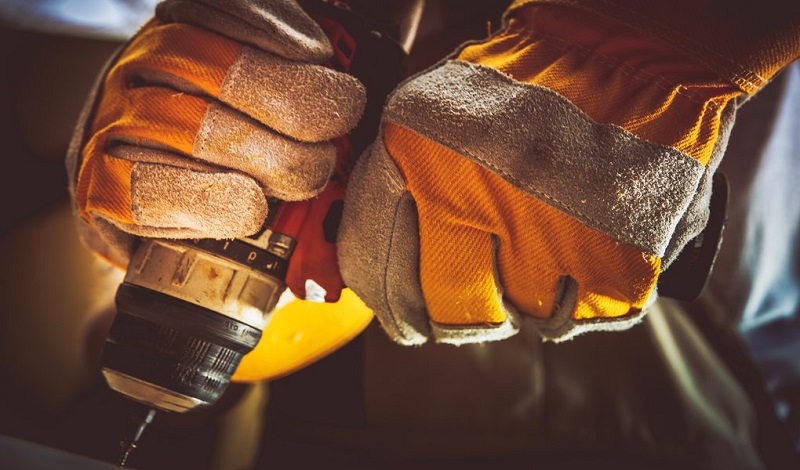 |
| Source: walmart.com |
Working on a construction site is a dangerous job. Any construction company owner or contractor is obligated to protect their workers from potential injuries at the worksite. The worker, no matter how careful and experienced, is always at risk of potential injuries such as tripping and falling, burn injuries from fumes, vapours or chemicals, breathing dust and other particles, etc. Also, these people can easily injure their heads from moving or non-moving objects.
Their sight and hearing are also at risk. To put it simply, the entire health of the worker is at potential risk of injuries or occupational diseases. To prevent that, the worker should get industrial protection products. These can include helmets, face or head respirators, whole body PPE safety gear (fire-retardant clothing, high-visibility clothing, protective footwear, gloves, glasses and so on).
What is PPE?
PPE includes items like gloves, eye protection, helmets, hazmat suits, safety footwear, high-visibility clothing, ear plygs, ear defenders and respiratory equipment (RPE). In some situations, a disposable PPE includes eg single-use coverals. Employers must use personal protective equipment at work.
A PPE safety gear does not include ordinary working clothes or uniforms that have no purpose to guard the health of the worker. Also, clothing provided for food hygiene processes isn't a part of this gear.
Your PPE won't include gear used for travelling on a public road such as bicycle helmets, or equipment used for sports such as life jackets. Portable devices for detecting or signalling risks and nuances like badges or detecting radiation or personal gas detectors won't take their place in a PPE gear.
Why is PPE important?
When it comes to risk control, PPE is considered as the lowest safety gear and is represented as the option of last resort. Industrial protection products are only suitable in places where the said hazard can't be entirely removed and controlled in a way that harm is not likely. PPE will protect only the person who uses it. Effective protection can only be accomplished by correctly fitting equipment that is maintained and properly used at all times. PPE is important since it's mainly used where other measures aren't sufficient enough. This is why such gear plays a crucial role in reducing numerous occupational injuries, diseases and fatalities.
Can PPE Protect You From Head Injuries?
 |
| Source: trekkergroup.com |
Yes, wearing hard hats can protect workers from head impact, penetration injuries and electrical injuries caused by falling or flying objects, fixed objects or electrical wires. If the worker has long hair, they are obligated to cover it to prevent it from getting caught in machine parts like belts and chains.
How does PPE Protects Workers From Leg and Foot Injuries?
The workers’ feet should be protected with suitable shoes that have protective toe and heel caps.
A pair of safety shoes and leggings made of leather or alymied rayon can protect the worker from injuries caused by falling or rolling objects, wet or slippery surfaces, molten metals, hot surfaces or electrical hazards.
Can PPE Prevent You From Eye and Face Injuries.
Yes, this type of equipment can protect the most vulnerable parts of your head. PPE has special helmets or shields, spectacles, side and face shields that can protect the employee from hazards from flying fragments, big chips, hot sparks, splashes from molten metals, optical radiation, and objects, particles, dirt, sand, dust, and glare.
How Can PPE Help Workers From Hearing Loss?
Wearing earplugs or earmuffs can help the worker protect their hearing. Exposure to high noise can cause irreversible hearing loss or impairment but also physical and psychological stress. Earplugs are made from waxed cotton, foam, or fibreglass wool; since the earplugs are self-forming they usually fit well. A professional should fit the employees individually for moulded or preformed earplugs. It's essential to clean the earplugs regularly and replace the pair if you cannot clean them thoroughly.
Should Workers Wear PPE to Prevent Hand Injuries?
 |
| Source: blog.sliceproducts.com |
Using hands is essential for any work, but if you work on a construction site or any place where you are exposed to potential hand injuries, you should wear protective gloves. This way you will protect your skin from cuts, lacerations, severe abrasions, thermal and chemical burns, as well as harmful temperature extremes.
Why Should Workers Wear PPE Protect to The Entire Body?
Some cases demand workers to protect their entire bodies. Potential hazards such as exposure to heat, radiation, hot metals, body fluids, scalding liquids or waste can be a high-risk threat for injuries and diseases of the entire body. Whole-body PPE is often made of rubber, leather, synthetic and plastic.
What About PPE for Respiratory Protection?
 |
| Source: safetygearpro.com |
In case engineering controls aren't attainable, the worker must use suitable respirators to protect against unfabourable health effects caused by breathing contaminated air. Harmful contaminators are gases, smokes, sprays, vapours, dust, fogs, fumes, mists. Respirators usually cover the nose and mouth or the entire face or head to prevent illness and injury. The respirator should have a proper fit to be effective. All employees required to wear respirators first must undergo a medical evaluation.
What Should I Look for When Buying PPE?
First of all, consider what standards apply to the equipment you're buying. Ask your supplier for evidence that their products are meeting the standards. A list of PPE standards are often available online so you can do your research. Inform about the standards so you can be sure you're getting the right things. In case you're buying things from overseas, make sure to check if the product is a subset to the same level of quality control and assurance as an Australian product. Make sure to always buy from trusted suppliers.
Comments
Post a Comment